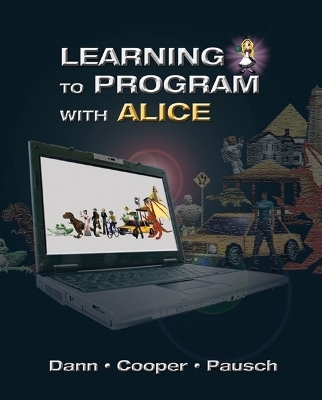
Learning to Program with Alice (w/ CD ROM)
Pearson
978-0-13-212247-4 (ISBN)
- Titel z.Zt. nicht lieferbar
- Versandkostenfrei innerhalb Deutschlands
- Auch auf Rechnung
- Verfügbarkeit in der Filiale vor Ort prüfen
- Artikel merken
¿
Alice was designed to make programming concepts easier to teach and learn. In the Third Edition of Learning to Program with Alice, Alice’s creators offer a complete full-color introduction to the interactive Alice programming environment. The authors make extensive use of program visualization to establish an easy, intuitive relationship between program constructs and the 3D graphics animation action in Alice. Students discover how Alice blends traditional problem-solving techniques with Hollywood-style storyboarding. Fundamental object-oriented programming concepts and language syntax are taught independently. Programming concepts can be taught from either an objects-first or an objects-early approach, with an optional early introduction to events. The book’s Java-like syntax allows students to view their program code, simplifying their transitions to Java, C++, C#, or other object-oriented languages. This new edition includes over 60% revised exercises and a "sneak peek" at Alice 3.0.
¿
Collection of Alice 3D “example worlds” on CD-ROM – Students can load an example world and enter their own code to make it work.
Wanda Dann is the Director of the Alice Project and Associate Teaching Professor of Computer Science at Carnegie Mellon University. Her research has encompassed program visualization and object-oriented and event-driven programming. She has published papers on the use of program visualization in computer science education for SIGCSE, the Computer Science Education Journal, and related publications. She has been co-PI for three NSF-funded projects. She is an active member of the ITiCSE Visualization Working Group, studying the effectiveness of visualization in computer science education. She has taken on a major leadership role in the international computer science education community, serving as SIGCSE 2004 Program co-Chair and SIGCSE 2005 Symposium co-Chair. Stephen Cooper is an Associate Professor of Computer Science and the Director for the Center for Visualization at Saint Joseph's University.¿He taught previously at Rivier College, serving as Computer Science program director. He has also worked at IBM as a systems programmer. Dr. Cooper's research interests lie in the semantics of programming languages as well as in program visualization. He is the author or co-author of a dozen articles, and has been the principal investigator for several National Science Foundation and private grants. ¿ Randy Pausch was a Professor of Computer Science, Human-Computer Interaction and Design at Carnegie Mellon, and co-founder of the Entertainment Technology Center. He also served as the Director of Carnegie Mellon's Alice research group, where he oversaw the development of Alice. He was a National Science Foundation Presidential Young Investigator and a Lilly Foundation Teaching Fellow. In 1995, he spent a Sabbatical with the Walt Disney Imagineering Virtual Reality Studio and consulted with Imagineering on interactive theme park attractions, particularly for the "DisneyQuest" virtual-reality based theme park. Dr. Pausch authored or co-authored five books and over 60 reviewed journal and conference proceedings articles, and his primary interests were human-computer interaction, entertainment technology and undergraduate education.
Foreword xi
Preface xiii
Acknowledgments xxi
About the Authors xxiii
Part I: Introduction to Alice 1
1 Getting Started with Alice 3
1-1 Introduction to Alice 3
1-2 Alice Concepts 8
Tips & Techniques 1: Special Effects: Text and 2D Graphic Images 15
Summary 18
Exercises 19
2 Program Design and Implementation 22
2-1 Scenarios and Storyboards 22
2-2 A First Program 29
Tips & Techniques 2: Orientation and Movement Instructions 43
Summary 57
Exercises 59
3 Programming: Putting Together the Pieces 62
3-1 Built-in Functions and Expressions 63
3-2 Simple Control Structures 68
Tips & Techniques 3: Camera and Animation Controls 76
Summary 81
Exercises 83
Part II: Object-Oriented and Event-Driven Programming
Concepts 87
4 Classes, Objects, Methods and Parameters 89
4-1 World-Level Methods 91
4-2 Parameters 100
4-3 Object-Level Methods and Inheritance 110
Tips & Techniques 4: Visible and Invisible Objects 121
Summary 127
Exercises and Projects 129
5 Interaction: Events and Event Handling 140
5-1 Interactive Programming 140
5-2 Parameters and Event Handling Methods 147
Tips & Techniques 5: Creating Your Own People Models 156
Summary 158
Exercises and Projects 159
Part III: Using Functions and Control Statements 171
6 Functions and If/Else 173
6-1 Functions 173
6-2 Execution Control with If/Else and Boolean Functions 180
Tips & Techniques 6: Random Numbers and Random Motion 196
Summary 199
Exercises and Projects 201
7 Repetition: Definite and Conditional Loops 213
7-1 Loops 213
7-2 While—a Conditional Loop 219
Tips & Techniques 7: Events and Repetition 225
Summary 228
Exercises and Projects 229
8 Repetition: Recursion 239
8-1 Introduction to Recursion 239
8-2 Another Flavor of Recursion 244
Tips & Techniques 8: Engineering Look and Feel 254
Summary 257
Exercises and Projects 258
Part IV: Advanced Topics 265
9 Lists and List Processing 267
9-1 Lists 267
9-2 List Search 273
Tips & Techniques 9: Groups 277
Summary 279
Exercises and Projects 280
10 Variables and Revisiting Inheritance 289
10-1 Variables 289
10-2 An Array Visualization Using an Index Variable 300
Tips & Techniques 10: Debugging with Watch and Text Output 308
Summary 312
Exercises and Projects 313
11 What’s Next? 322
11-1 Transition to Java 322
11-2 Alice 3 327
Tips & Techniques 11: Poses 328
Appendix A: Using Alice 331
Part 1: Running Virtual Worlds in Alice 331
Part 2: Using Popup Menus to Create an Initial Scene 345
Appendix B: Managing the Alice Interface 350
Index 363
| Erscheint lt. Verlag | 21.4.2011 |
|---|---|
| Sprache | englisch |
| Maße | 203 x 255 mm |
| Gewicht | 670 g |
| Themenwelt | Schulbuch / Wörterbuch |
| Mathematik / Informatik ► Informatik ► Programmiersprachen / -werkzeuge | |
| Informatik ► Software Entwicklung ► Objektorientierung | |
| ISBN-10 | 0-13-212247-2 / 0132122472 |
| ISBN-13 | 978-0-13-212247-4 / 9780132122474 |
| Zustand | Neuware |
| Haben Sie eine Frage zum Produkt? |